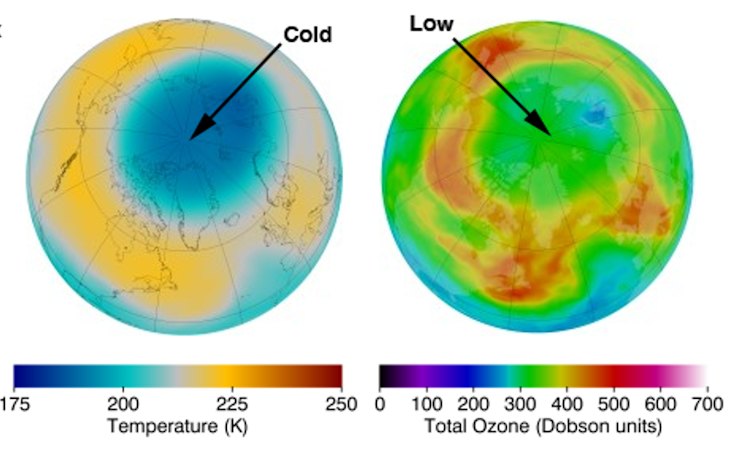By Beatriz Monge-Sanz
Global warming caused by increased concentrations of greenhouse gases is already affecting our lives. Scorching summers, more intense heatwaves, longer drought periods, more extended floods, and wilder wildfires are consequences linked to this warming.
One less obvious consequence of global warming is also getting growing attention from scientists: a potential increase in the intensity and frequency of winter cold snaps in the northern hemisphere.
Weather phenomena like the Beast from the East in winter 2018, the cold spell of Arctic air that reached as far South as Texas in February 2021, or the storm that left Madrid and Athens unusually covered in snow for days in early 2021 are becoming more common.
Some of the mechanisms that lead to their occurrence are strengthened by global warming. Key climate mechanisms, like exchanges of energy and air masses between different altitude ranges in the atmosphere, are evolving in ways expected to cause an increase in both the intensity and duration of cold snaps. These link to the behaviour of a region in the high atmosphere called the stratosphere.
Winter cold snaps have major societal impacts, from direct effects on health and loss of life, to effects on transport and infrastructure, surges in energy demand and damage to agricultural resources.

This winter, we have seen these effects over large parts of Europe and the US, with flight cancellations, airport closures, road queues and drivers trapped in extreme cold temperatures. There have also been sharp increases in energy demand to cope with indoor heating, an increase in cold-related hospital admissions and the activation of services needed to assist the most vulnerable.
We need to develop forecasting tools that can predict these events further in advance.
Polar vortex
Some of these cold snaps are linked to disruptions in a seasonal atmospheric phenomenon called the stratospheric polar vortex (SPV).
In the northern hemisphere, this vortex consists of masses of cold air centred over the north pole, surrounded by a jet of very strong westerly winds between 15-50km above ground. These spinning winds act as a wall and keep cold air confined to the Arctic region, stopping it from travelling to lower latitudes.
Something that can disrupt the vortex is a sudden stratospheric warming (SSW), when the stratosphere experiences an abrupt increase in temperature due to energy and momentum being transferred from lower to higher altitudes.
When a major SSW occurs, the wall of strong winds around the polar stratosphere can break, allowing cold air to escape the polar vortex and travel down to lower atmospheric altitudes and lower latitudes. When that air approaches the Earth’s surface, significant cold spells can occur.
Even when SSWs are not strong enough to break the vortex, they can weaken it. This can cause polar air circulation patterns to meander further south into lower latitudes, reaching populated areas of North America and Eurasia, instead of staying nearer the north pole. Those areas can then experience temperatures tens of degrees lower than their winter average.
Under climate change, the transfer of energy from the lowest layers of the Earth’s atmosphere to the higher stratospheric layer is changing and seems to be disrupting the polar vortex to a greater degree. A study has shown that the strength and duration of SSWs in the stratosphere have increased over the last 40 years. This increase is also expected to result in stronger winter cold snaps at surface levels.

Forecasting challenge
Accurately forecasting these cold snaps is crucial for helping society prepare appropriately for them. Developing computer-based forecasting tools that reproduce realistic interactions between the lower levels of the troposphere and the stratospheric region is an essential step towards this goal.
To correctly simulate the behaviour of the stratosphere and how it interacts with the troposphere, forecasting tools must include realistic descriptions of the abundance and distribution of stratospheric ozone. Ozone influences the interaction of air masses outside and inside the vortex, and therefore also the transport of colder air from higher to lower altitudes.
However, including all the chemical processes that ozone is involved in, at the resolution needed to predict these weather events, is prohibitive in terms of the computing power needed. This is even truer if we want to predict events one season ahead.
My research looks at ways to improve forecasting models to better capture the type of stratospheric behaviour that leads to these cold spells. To do this I have developed alternatives that can realistically simulate processes in the stratosphere, including aspects of ozone chemistry, using less computing power.
In a study I led, we used these alternatives to simulate interactions between the ozone layer, temperature and solar radiation in the global computer model used to produce some of the best weather forecasts in the world.
The experiments we did with this model showed that including this realistic alternative representation of stratospheric ozone led to improvements in simulations of temperature distribution in the stratosphere. This means that it can help provide useful information about triggers of cold spells like SSWs.
Developing and using these alternatives in climate modelling is a significant milestone towards what we call seamless prediction: using the same computer modelling tools to predict both weather and climate. This allows for a more accurate establishment of causal links between climate change and extreme weather events.
A question many may be wondering is if this extreme cold could be counteracting global warming. Unfortunately, not. While this winter has brought days of extremely cold temperatures and heavy snowfall in the northern hemisphere, the current summer in the southern hemisphere has seen some of the hottest days on record for populated areas of Australia, with temperatures of around 50ºC.
Global warming makes extreme weather more extreme, and scientific studies are starting to provide proof that this also applies to extreme winter cold spells. Developing the best possible modelling tools is essential to predict the evolution of extreme weather events in the coming years so that we can be better prepared for them.




